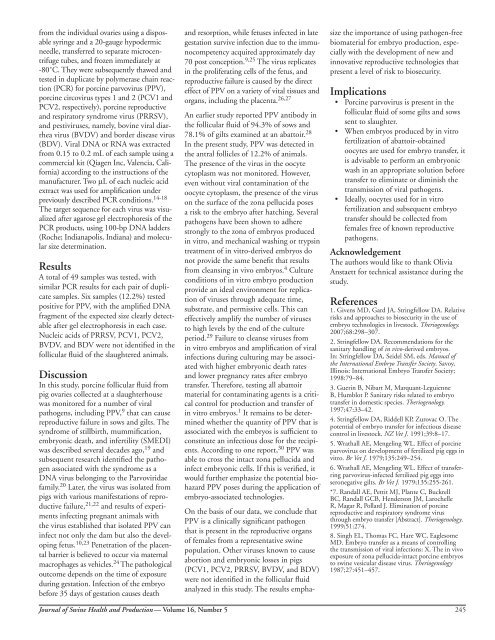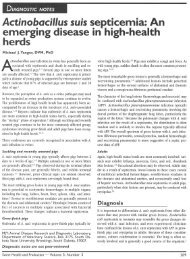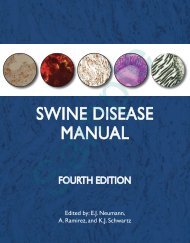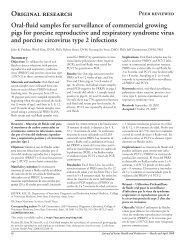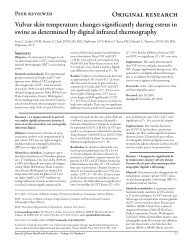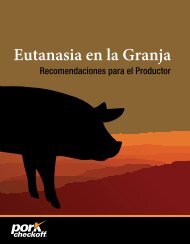Detection of porcine parvovirus in the follicular fluid of abattoir pigs
Detection of porcine parvovirus in the follicular fluid of abattoir pigs
Detection of porcine parvovirus in the follicular fluid of abattoir pigs
You also want an ePaper? Increase the reach of your titles
YUMPU automatically turns print PDFs into web optimized ePapers that Google loves.
from <strong>the</strong> <strong>in</strong>dividual ovaries us<strong>in</strong>g a disposable<br />
syr<strong>in</strong>ge and a 20-gauge hypodermic<br />
needle, transferred to separate microcentrifuge<br />
tubes, and frozen immediately at<br />
-80˚C. They were subsequently thawed and<br />
tested <strong>in</strong> duplicate by polymerase cha<strong>in</strong> reaction<br />
(PCR) for <strong>porc<strong>in</strong>e</strong> <strong>parvovirus</strong> (PPV),<br />
<strong>porc<strong>in</strong>e</strong> circovirus types 1 and 2 (PCV1 and<br />
PCV2, respectively), <strong>porc<strong>in</strong>e</strong> reproductive<br />
and respiratory syndrome virus (PRRSV),<br />
and pestiviruses, namely, bov<strong>in</strong>e viral diarrhea<br />
virus (BVDV) and border disease virus<br />
(BDV). Viral DNA or RNA was extracted<br />
from 0.15 to 0.2 mL <strong>of</strong> each sample us<strong>in</strong>g a<br />
commercial kit (Qiagen Inc, Valencia, California)<br />
accord<strong>in</strong>g to <strong>the</strong> <strong>in</strong>structions <strong>of</strong> <strong>the</strong><br />
manufacturer. Two µL <strong>of</strong> each nucleic acid<br />
extract was used for amplification under<br />
previously described PCR conditions. 14-18<br />
The target sequence for each virus was visualized<br />
after agarose gel electrophoresis <strong>of</strong> <strong>the</strong><br />
PCR products, us<strong>in</strong>g 100-bp DNA ladders<br />
(Roche; Indianapolis, Indiana) and molecular<br />
size determ<strong>in</strong>ation.<br />
Results<br />
A total <strong>of</strong> 49 samples was tested, with<br />
similar PCR results for each pair <strong>of</strong> duplicate<br />
samples. Six samples (12.2%) tested<br />
positive for PPV, with <strong>the</strong> amplified DNA<br />
fragment <strong>of</strong> <strong>the</strong> expected size clearly detectable<br />
after gel electrophoresis <strong>in</strong> each case.<br />
Nucleic acids <strong>of</strong> PRRSV, PCV1, PCV2,<br />
BVDV, and BDV were not identified <strong>in</strong> <strong>the</strong><br />
<strong>follicular</strong> <strong>fluid</strong> <strong>of</strong> <strong>the</strong> slaughtered animals.<br />
Discussion<br />
In this study, <strong>porc<strong>in</strong>e</strong> <strong>follicular</strong> <strong>fluid</strong> from<br />
pig ovaries collected at a slaughterhouse<br />
was monitored for a number <strong>of</strong> viral<br />
pathogens, <strong>in</strong>clud<strong>in</strong>g PPV, 9 that can cause<br />
reproductive failure <strong>in</strong> sows and gilts. The<br />
syndrome <strong>of</strong> stillbirth, mummification,<br />
embryonic death, and <strong>in</strong>fertility (SMEDI)<br />
was described several decades ago, 19 and<br />
subsequent research identified <strong>the</strong> pathogen<br />
associated with <strong>the</strong> syndrome as a<br />
DNA virus belong<strong>in</strong>g to <strong>the</strong> Parvoviridae<br />
family. 20 Later, <strong>the</strong> virus was isolated from<br />
<strong>pigs</strong> with various manifestations <strong>of</strong> reproductive<br />
failure, 21,22 and results <strong>of</strong> experiments<br />
<strong>in</strong>fect<strong>in</strong>g pregnant animals with<br />
<strong>the</strong> virus established that isolated PPV can<br />
<strong>in</strong>fect not only <strong>the</strong> dam but also <strong>the</strong> develop<strong>in</strong>g<br />
fetus. 10,23 Penetration <strong>of</strong> <strong>the</strong> placental<br />
barrier is believed to occur via maternal<br />
macrophages as vehicles. 24 The pathological<br />
outcome depends on <strong>the</strong> time <strong>of</strong> exposure<br />
dur<strong>in</strong>g gestation. Infection <strong>of</strong> <strong>the</strong> embryo<br />
before 35 days <strong>of</strong> gestation causes death<br />
and resorption, while fetuses <strong>in</strong>fected <strong>in</strong> late<br />
gestation survive <strong>in</strong>fection due to <strong>the</strong> immunocompetency<br />
acquired approximately day<br />
70 post conception. 9,25 The virus replicates<br />
<strong>in</strong> <strong>the</strong> proliferat<strong>in</strong>g cells <strong>of</strong> <strong>the</strong> fetus, and<br />
reproductive failure is caused by <strong>the</strong> direct<br />
effect <strong>of</strong> PPV on a variety <strong>of</strong> vital tissues and<br />
organs, <strong>in</strong>clud<strong>in</strong>g <strong>the</strong> placenta. 26,27<br />
An earlier study reported PPV antibody <strong>in</strong><br />
<strong>the</strong> <strong>follicular</strong> <strong>fluid</strong> <strong>of</strong> 94.3% <strong>of</strong> sows and<br />
78.1% <strong>of</strong> gilts exam<strong>in</strong>ed at an <strong>abattoir</strong>. 28<br />
In <strong>the</strong> present study, PPV was detected <strong>in</strong><br />
<strong>the</strong> antral follicles <strong>of</strong> 12.2% <strong>of</strong> animals.<br />
The presence <strong>of</strong> <strong>the</strong> virus <strong>in</strong> <strong>the</strong> oocyte<br />
cytoplasm was not monitored. However,<br />
even without viral contam<strong>in</strong>ation <strong>of</strong> <strong>the</strong><br />
oocyte cytoplasm, <strong>the</strong> presence <strong>of</strong> <strong>the</strong> virus<br />
on <strong>the</strong> surface <strong>of</strong> <strong>the</strong> zona pellucida poses<br />
a risk to <strong>the</strong> embryo after hatch<strong>in</strong>g. Several<br />
pathogens have been shown to adhere<br />
strongly to <strong>the</strong> zona <strong>of</strong> embryos produced<br />
<strong>in</strong> vitro, and mechanical wash<strong>in</strong>g or tryps<strong>in</strong><br />
treatment <strong>of</strong> <strong>in</strong> vitro-derived embryos do<br />
not provide <strong>the</strong> same benefit that results<br />
from cleans<strong>in</strong>g <strong>in</strong> vivo embryos. 4 Culture<br />
conditions <strong>of</strong> <strong>in</strong> vitro embryo production<br />
provide an ideal environment for replication<br />
<strong>of</strong> viruses through adequate time,<br />
substrate, and permissive cells. This can<br />
effectively amplify <strong>the</strong> number <strong>of</strong> viruses<br />
to high levels by <strong>the</strong> end <strong>of</strong> <strong>the</strong> culture<br />
period. 29 Failure to cleanse viruses from<br />
<strong>in</strong> vitro embryos and amplification <strong>of</strong> viral<br />
<strong>in</strong>fections dur<strong>in</strong>g cultur<strong>in</strong>g may be associated<br />
with higher embryonic death rates<br />
and lower pregnancy rates after embryo<br />
transfer. Therefore, test<strong>in</strong>g all <strong>abattoir</strong><br />
material for contam<strong>in</strong>at<strong>in</strong>g agents is a critical<br />
control for production and transfer <strong>of</strong><br />
<strong>in</strong> vitro embryos. 1 It rema<strong>in</strong>s to be determ<strong>in</strong>ed<br />
whe<strong>the</strong>r <strong>the</strong> quantity <strong>of</strong> PPV that is<br />
associated with <strong>the</strong> embryos is sufficient to<br />
constitute an <strong>in</strong>fectious dose for <strong>the</strong> recipients.<br />
Accord<strong>in</strong>g to one report, 30 PPV was<br />
able to cross <strong>the</strong> <strong>in</strong>tact zona pellucida and<br />
<strong>in</strong>fect embryonic cells. If this is verified, it<br />
would fur<strong>the</strong>r emphasize <strong>the</strong> potential biohazard<br />
PPV poses dur<strong>in</strong>g <strong>the</strong> application <strong>of</strong><br />
embryo-associated technologies.<br />
On <strong>the</strong> basis <strong>of</strong> our data, we conclude that<br />
PPV is a cl<strong>in</strong>ically significant pathogen<br />
that is present <strong>in</strong> <strong>the</strong> reproductive organs<br />
<strong>of</strong> females from a representative sw<strong>in</strong>e<br />
population. O<strong>the</strong>r viruses known to cause<br />
abortion and embryonic losses <strong>in</strong> <strong>pigs</strong><br />
(PCV1, PCV2, PRRSV, BVDV, and BDV)<br />
were not identified <strong>in</strong> <strong>the</strong> <strong>follicular</strong> <strong>fluid</strong><br />
analyzed <strong>in</strong> this study. The results emphasize<br />
<strong>the</strong> importance <strong>of</strong> us<strong>in</strong>g pathogen-free<br />
biomaterial for embryo production, especially<br />
with <strong>the</strong> development <strong>of</strong> new and<br />
<strong>in</strong>novative reproductive technologies that<br />
present a level <strong>of</strong> risk to biosecurity.<br />
Implications<br />
• Porc<strong>in</strong>e <strong>parvovirus</strong> is present <strong>in</strong> <strong>the</strong><br />
<strong>follicular</strong> <strong>fluid</strong> <strong>of</strong> some gilts and sows<br />
sent to slaughter.<br />
• When embryos produced by <strong>in</strong> vitro<br />
fertilization <strong>of</strong> <strong>abattoir</strong>-obta<strong>in</strong>ed<br />
oocytes are used for embryo transfer, it<br />
is advisable to perform an embryonic<br />
wash <strong>in</strong> an appropriate solution before<br />
transfer to elim<strong>in</strong>ate or dim<strong>in</strong>ish <strong>the</strong><br />
transmission <strong>of</strong> viral pathogens.<br />
• Ideally, oocytes used for <strong>in</strong> vitro<br />
fertilization and subsequent embryo<br />
transfer should be collected from<br />
females free <strong>of</strong> known reproductive<br />
pathogens.<br />
Acknowledgement<br />
The authors would like to thank Olivia<br />
Anstaett for technical assistance dur<strong>in</strong>g <strong>the</strong><br />
study.<br />
References<br />
1. Givens MD, Gard JA, Str<strong>in</strong>gfellow DA. Relative<br />
risks and approaches to biosecurity <strong>in</strong> <strong>the</strong> use <strong>of</strong><br />
embryo technologies <strong>in</strong> livestock. Theriogenology.<br />
2007;68:298–307.<br />
2. Str<strong>in</strong>gfellow DA. Recommendations for <strong>the</strong><br />
sanitary handl<strong>in</strong>g <strong>of</strong> <strong>in</strong> vivo-derived embryos.<br />
In: Str<strong>in</strong>gfellow DA, Seidel SM, eds. Manual <strong>of</strong><br />
<strong>the</strong> International Embryo Transfer Society. Savoy,<br />
Ill<strong>in</strong>ois: International Embryo Transfer Society;<br />
1998:79–84.<br />
3. Guer<strong>in</strong> B, Nibart M, Marquant-Leguienne<br />
B, Humblot P. Sanitary risks related to embryo<br />
transfer <strong>in</strong> domestic species. Theriogenology.<br />
1997;47:33–42.<br />
4. Str<strong>in</strong>gfellow DA, Riddell KP, Zurovac O. The<br />
potential <strong>of</strong> embryo transfer for <strong>in</strong>fectious disease<br />
control <strong>in</strong> livestock. NZ Vet J. 1991;39:8–17.<br />
5. Wrathall AE, Mengel<strong>in</strong>g WL. Effect <strong>of</strong> <strong>porc<strong>in</strong>e</strong><br />
<strong>parvovirus</strong> on development <strong>of</strong> fertilized pig eggs <strong>in</strong><br />
vitro. Br Vet J. 1979;135:249–254.<br />
6. Wrathall AE, Mengel<strong>in</strong>g WL. Effect <strong>of</strong> transferr<strong>in</strong>g<br />
<strong>parvovirus</strong>-<strong>in</strong>fected fertilized pig eggs <strong>in</strong>to<br />
seronegative gilts. Br Vet J. 1979;135:255-261.<br />
*7. Randall AE, Pettit MJ, Plante C, Buckrell<br />
BC, Randall GCB, Henderson JM, Larochelle<br />
R, Magar R, Pollard J. Elim<strong>in</strong>ation <strong>of</strong> <strong>porc<strong>in</strong>e</strong><br />
reproductive and respiratory syndrome virus<br />
through embryo transfer [Abstract]. Theriogenology.<br />
1999;51:274.<br />
8. S<strong>in</strong>gh EL, Thomas FC, Hare WC, Eaglesome<br />
MD. Embryo transfer as a means <strong>of</strong> controll<strong>in</strong>g<br />
<strong>the</strong> transmission <strong>of</strong> viral <strong>in</strong>fections: X. The <strong>in</strong> vivo<br />
exposure <strong>of</strong> zona pellucida-<strong>in</strong>tact <strong>porc<strong>in</strong>e</strong> embryos<br />
to sw<strong>in</strong>e vesicular disease virus. Theriogenology<br />
1987;27:451–457.<br />
Journal <strong>of</strong> Sw<strong>in</strong>e Health and Production — Volume 16, Number 5<br />
245


